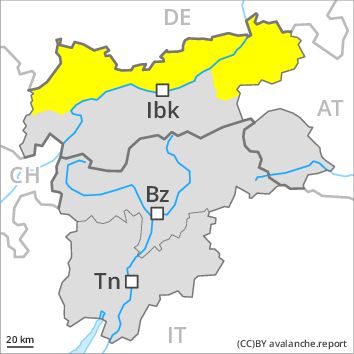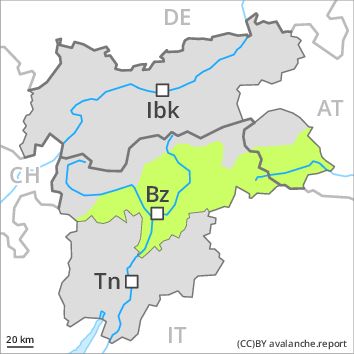Regions
Karwendel Mountains, Brandenberg Alps, Western Kitzbühel Alps, Wilder Kaiser Mountains - Waidring Alps, Eastern Kitzbühel Alps, Western Lechtal Alps, Central Lechtal Alps, Allgäu Alps, Eastern Lechtal Alps - Ammergau Alps, Mieming Mountains

Danger level
Danger Level 2 - Moderate
Avalanche Problem
Wind-drifted snow above the treeline, N-NE-E-SE-NW
Wet snow above 2200m, N-NE-E-SE-S-SW-W-NW

Above the tree line: Fresh wind slabs require caution. In some regions rain to 2200 m.
The wind will be strong to storm force in the vicinity of peaks. Fresh and somewhat older wind slabs can be released by a single winter sport participant in some cases in particular on northwest to north to southeast facing aspects above the tree line. In some cases avalanches are medium-sized. In high Alpine regions avalanche prone locations are more prevalent. These avalanche prone locations are clearly recognisable to the trained eye.
Weakly bonded old snow: In very isolated cases avalanches can be released in the old snowpack and reach dangerously large size in particular on little-used, rather lightly snow-covered shady slopes. Caution is to be exercised in particular at transitions from a shallow to a deep snowpack in little used backcountry terrain, in isolated cases also in areas close to the tree line. These avalanche prone locations are very rare and are difficult to recognise.
In the past few hours the weather has been exceptionally warm over a wide area. Below approximately 2200 m: As a consequence of the rain, the likelihood of moist and wet snow slides being released will increase a little.
Snowpack
dp 6: cold, loose snow and wind
dp 3: rain
Intermediate and high altitudes: In some regions rain. The snowpack will be in some cases moist, in the regions exposed to rain in particular below approximately 2200 m as well as.
5 to 10 cm of snow. will fall above approximately 2200 m. The snowpack will be subject to considerable local variations. In the last few days mostly small wind slabs formed in particular in gullies and bowls and behind abrupt changes in the terrain. Faceted weak layers exist in the old snowpack. On south and southwest facing slopes a little snow is lying at low and intermediate altitudes.
There is a danger of falling on the hard snow surface.
Tendency
Fresh and older wind slabs require caution.
Regions
Weißkugel Range, Western Verwall Mountains, Gurgler Range, Central Stubai Alps, Eastern Verwall Mountains, Northern Zillertal Alps, Silvretta, Venediger Range, Samnaun Mountains, Northern Oetz and Stubai Alps, Western Tuxer Alps, Eastern Tuxer Alps, Glockturm Range, Grieskogel Mountains

Danger level
Danger Level 2 - Moderate
Avalanche Problem
Wind-drifted snow above 2200m, N-NE-E-SE-NW
Wet snow above 2200m, N-NE-E-SE-S-SW-W-NW

Fresh wind slabs require caution. Rain below approximately 2200 m.
As a consequence of fresh snow and a strong to storm force wind from westerly directions, further wind slabs will form in particular at elevated altitudes. Fresh and somewhat older wind slabs can be released by a single winter sport participant in some cases in particular on northwest to north to southeast facing aspects above approximately 2200 m. In some cases avalanches are medium-sized. In high Alpine regions avalanche prone locations are more prevalent.
Weakly bonded old snow: In very isolated cases avalanches can be released in the old snowpack and reach dangerously large size in particular on very steep shady slopes. Caution is to be exercised in particular at transitions from a shallow to a deep snowpack in little used backcountry terrain, in isolated cases also in areas close to the tree line. These avalanche prone locations are very rare and are barely recognisable.
In the past few hours the weather has been exceptionally warm. As a consequence of heat and rain a moderate danger of wet avalanches will prevail, in particular below approximately 2200 m.
Snowpack
dp 6: cold, loose snow and wind
In some regions rain below approximately 2200 m. The snowpack will be in some cases moist, in the regions exposed to rain especially below approximately 2200 m as well as.
5 to 10 cm of snow, and even more in some localities, will fall above approximately 2200 m. Over a wide area strong westerly wind. The snowpack will be subject to considerable local variations. In the last few days mostly small wind slabs formed in particular in gullies and bowls and behind abrupt changes in the terrain. Faceted weak layers exist in the old snowpack on shady slopes. On south and southwest facing slopes a little snow is lying at low and intermediate altitudes.
There is a danger of falling on the hard snow surface.
Tendency
Fresh and older wind slabs require caution.
Regions
Texel Mountains, Glockner Range, Durreck Range, Western Rieserferner Mountains, Val Müstair Alps, Langtaufers, Ortler Range, Schnals Ridge, Southern Stubai Alps, Southern Zillertal Alps and High Tauern, Saldurn-Mastaun Ridge, Eastern Rieserferner Mountains

Danger level
Danger Level 2 - Moderate above 2200m
Danger Level 1 - Low above 2200m
Avalanche Problem
Wind-drifted snow above 2200m, N-NE-E-SE-NW

Fresh wind slabs require caution.
Fresh and somewhat older wind slabs can be released by a single winter sport participant in some cases in particular on northwest to north to southeast facing aspects above approximately 2200 m. In some cases avalanches are medium-sized. In high Alpine regions avalanche prone locations are more prevalent.
Weakly bonded old snow: In very isolated cases avalanches can be released in the old snowpack and reach dangerously large size in particular on very steep shady slopes. Caution is to be exercised in particular at transitions from a shallow to a deep snowpack in little used backcountry terrain, in isolated cases also in areas close to the tree line.
Snowpack
dp 6: cold, loose snow and wind
Some snow will fall in some localities. As the day progresses mostly small wind slabs will form in particular in gullies and bowls and behind abrupt changes in the terrain. Faceted weak layers exist in the old snowpack. The snowpack will be subject to considerable local variations. On south and southwest facing slopes a little snow is lying at low and intermediate altitudes. In steep terrain there is a danger of falling on the hard snow surface.
Tendency
The backcountry touring conditions are generally favourable. Fresh and older wind slabs require caution.
Regions
Sexten Dolomites, Eastern Pfunderer Mountains, Western Deferegger Alps, Ulten Valley, Eastern Nonsberger Alps, Northern Dolomites of Fiemme, Gröden Dolomites, Prags Dolomites, Sarntal Alps, Eastern Deferegger Alps, Western Pfunderer Mountains, Schober Mountains, Lienzer Dolomites

Danger level
Danger Level 1 - Low
Avalanche Problem
Wind-drifted snow above 2400m, N-NE-E-SE-NW

The backcountry touring conditions are favourable over a wide area.
The rather small wind slabs have bonded quite well with the old snowpack. These can only be released by large loads in most cases. The avalanche prone locations are to be found in particular on northwest to north to southeast facing wind-loaded slopes above approximately 2400 m, especially in gullies and bowls, and behind abrupt changes in the terrain. These places are clearly recognisable to the trained eye.
In steep terrain there is a danger of falling on the hard snow surface.
Snowpack
dp 6: cold, loose snow and wind
The fresh and somewhat older wind slabs are mostly small and can only be released in isolated cases. In some cases relatively hard layers of snow are lying on old snow containing large grains. Faceted weak layers exist deep in the snowpack in particular on shady slopes. The snowpack will be subject to considerable local variations. On south and southwest facing slopes a little snow is lying in all altitude zones.
Tendency
The backcountry touring conditions are generally favourable.




